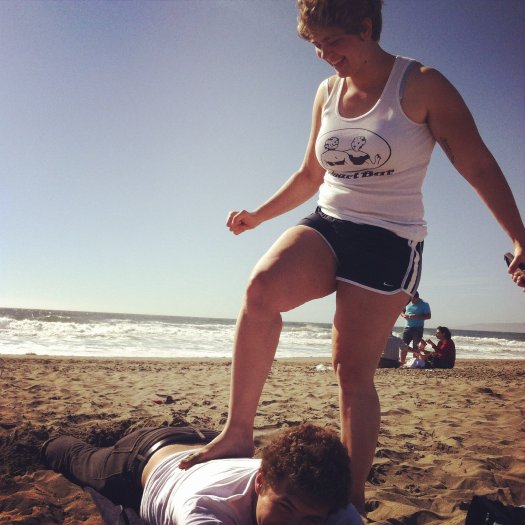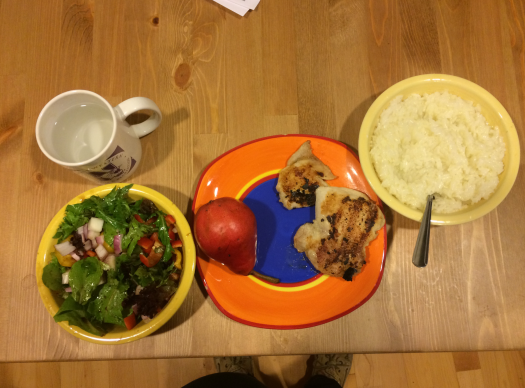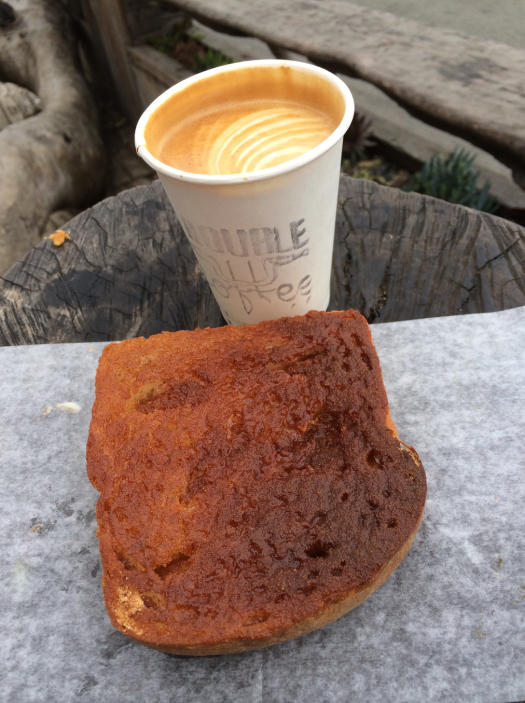My fitness and weight loss journey began in the summer of 2011. There have been many ups and downs and numerous phases along the way. I’ve lost weight, regained it, and lost it again more times than I can count. Every time, I learn more about myself and the process of coaching others through challenging behavior changes.
However, not many people know about one of the most successful periods of my journey when I lost 30 pounds without counting calories, weighing myself regularly, or stressing out about food. This occurred in 2014 and 2015 when I spent a year living in San Francisco.

Me at the start of the year, at my heaviest since my initial weight loss
How was I able to effortlessly undergo a pretty dramatic transformation while still exploring one of the world’s best food cities and having tons of fun?
I unconsciously established a healthy routine and followed it religiously while still allowing myself room to enjoy life.
This article examines the four key areas that helped me achieve this success. Think about the ways these four areas play into your own ongoing health and fitness journey and use my experience to consider tweaks you could make yourself.

Me at the end of the year, thirty pounds lighter.
Food
The most important component to my success was falling into a regular eating routine that put me in a caloric deficit.
I say this was relatively effortless because I honestly didn’t put a lot of thought into designing my meals or weekly eating structure. I combined my past successful experience dieting with my basic nutritional knowledge to find meals that were easy to prepare and I genuinely enjoyed. I ate these same meals at the same time most days of the week for many months in a row. This made shopping, cooking, and planning an absolute breeze after just a couple of weeks.
This was the exact eating schedule I followed 5-6 days of the week:
- Breakfast: 3 – 4 whole eggs with sauteed spinach, tomatoes, onions, mushrooms, and garlic, all cooked in ½ – 1 TBSP kerrygold butter
- Lunch: ½ lb extra lean grass fed ground beef (or sometimes chicken breast), cooked as a bunless burger. Steamed broccoli or brussels sprouts. Baby carrots. One piece of fruit like an apple or an orange
- Dinner: 2 or 3 grilled chicken thighs. ½ -¾ dry cup jasmine rice served with ½ – 1 TBSP olive oil. Side salad with red onion, tomato, avocado, bell pepper, lime juice, cilantro, and avocado oil. One piece of fruit, usually a pear.

I loved this dinner and ate it almost every evening.
One thing you may notice is all of these meals follow Precision Nutrition’s hand portion control system. Each meal has about 2 palms of protein, 2 fists of veggies, 1-2 cupped hands of carbs, and 1-2 thumbs of fat.
Each meal was balanced and covered all of the important food groups. Overall this eating plan fits into a higher protein, moderate carb, and moderate fat blueprint. I found if I didn’t eat a healthy amount of carbs at dinner (usually in the form of white rice), my performance in the gym and energy levels throughout the day suffered. But I also didn’t shy away from healthy fats and consumed a moderate amount with each meal.
On the weekends, I ate out 1 – 3 times. I never paid much attention to what these meals were and used them as an opportunity to enjoy the amazing food in the city.
Frequent meals included burritos, ramen or other asian food, and enormous deli sandwiches. Most weekend mornings I met some friends for a full-fat latte and expensive piece of toast at Trouble Coffee. If I wasn’t eating out, I usually ate fewer and lighter meals than during the week.
In short, I left myself enough wiggle room on the weekends to enjoy great food and treat myself without going overboard.

I ate a lot of burritos.
Takeaway: Although I have used calorie counting a great deal in my weight loss journey, you don’t really need it to see dramatic transformations. The important things are to use a system to monitor your portion sizes and to balance out higher calorie meals on the weekends so overall you set up a caloric deficit throughout the week.
One of the easiest ways to do this is to eat the same meals most days of the week. This removes guess work, reduces hunger and cravings, and helps make your food prep significantly easier.

This article wouldn’t be complete without a photo of my Trouble order.
Training
Just as I did with my nutrition, I found a training routine and stuck with it diligently throughout this process.
I used several free or low-cost programs written by fitness pros I respected. Once I decided on a plan, I followed it all the way through, which was usually around 3 months.
Conveniently, the end of each program usually coincided with a vacation or trip which allowed me to take a week off of training. Afterwards I jumped right into the next program.
This is the exact program I found for free on T-Nation and followed for the first ten weeks of my transformation. As you can see, the program includes 5 days of challenging workouts. There is an alternating emphasis on heavy compound lifts and lighter, high rep pump work. The program also includes a lot of interval training using bodyweight movements, throws and jumps, and sprints on the bike and rowing machine.
I followed this plan religiously and didn’t miss a single workout during the 10 weeks. I saw noticeable improvements in my strength, endurance, and muscle definition. At the end of the program I was able to squat 225 pounds; this was only the second time in my life I ever successfully hit that number.
Later in the year I ran through Bret Contreras’ Strong Curves (my second time going through the program) and a muscle-building program from Nia Shanks. (*Note – I purchased this program from Nia’s website and intended to link to it but it appears she is no longer selling it. I’ve loved Nia’s work for many years and am sure any other program on her site that seems right for you would be a great choice).
With each of these programs I was training hard 4-5 times per week, focusing on slowly improving my performance on everything I did. Each program placed a premium on strength training and used supplemental accessory lifts to build muscle in strategic areas.
Takeaway: Find a program that makes sense for your ability level and goals and follow it all the way through. You can also hire a coach to tailor-make a program for you. The most important thing is to train consistently and to constantly push yourself to improve your performance and test your limits.
On a personal note, I have always made the biggest changes to my physique when I was training 5-6 days per week. The workouts don’t all need to be hard lifting workouts. However, if you really want to see dramatic physique transformations and you have some previous training experience, are healthy, and recover well, you may want to consider increasing your training frequency.
Non-exercise activity
In addition to hard training, I led an extremely active life in San Francisco.
I walked everywhere. I was constantly exploring new neighborhoods and parks in the city. Some days I would walk several hours getting to and from my obligations and checking out my surroundings. On the weekends I walked to the beach or spent lots of time on my feet. I went out dancing at night and took weekend hiking trips throughout the Bay area.
Although it may seem like such activities burn relatively few calories, altogether they really add up over the course of weeks and months.
Takeaway: Don’t be sedentary. Find ways to walk as much as possible. Take the stairs instead of the elevator, park farther away, walk or bike somewhere instead of driving, and spend your free time participating in active hobbies. It may not seem like much, but all of this low-intensity activity really helps when trying to lose fat and improve your overall health.
Sleep
During the year I lived in San Francisco, I made sleep a very high priority. I got around 9 hours during the week and only a bit less on the weekends.
I accomplished this by setting fairly rigid bedtimes and wake times. If I was feeling a bit behind, I found a park and took a 20-minute power nap. I also took longer naps on Friday and Saturday evenings if I knew I would be out late at night.
I cannot overstate how awesome I felt getting this much sleep. I felt sharp and focused on all of my tasks and had plenty of energy to train hard, be active, and enjoy my life. It was also easier for me to resist food temptations as I experienced very few daily cravings.
Takeaway: Don’t underestimate the power of sleep when trying to change your body or get healthy. Sleep makes it easier for your body to recharge and repair itself. Getting enough sleep helps you feel energized, focused, and well-prepared for everything life throws at you. Adequate sleep can also help you resist cravings and better manage hunger during a diet.
I totally understand sleeping for this long may be impractical for most people. These days, I am lucky to get 7 hours of sleep with my work schedule. However, you can get some of the same benefits by following a regular sleep routine. Set a bedtime and/or wake time and stick with them as much as possible. If you fall behind, set aside some time for a short nap to refresh and recharge.
Routine = Freedom
I learned some very powerful lessons about weight loss and healthy living during my year in San Francisco:
- You don’t need to count calories to lose weight. Instead, find a way to monitor portions and account for excess calorie intake on the weekends. Cook most of your own meals, don’t snack or drink too often, and get into a consistent routine.
- Find a training program or a coach and follow instructions precisely for several months. Train hard, but listen to your body and never compromise good form for higher numbers. Focus on strength training but don’t neglect cardio. If you can train more often (while still being smart), you may see more dramatic results.
- Be as active as possible outside the gym. This is great for both physical and mental health.
- Prioritize sleep, stress reduction, and other recovery methods.

Me at the start of the year, at my heaviest since my initial weight loss.
Most importantly, my year in San Francisco taught me that routine allows you more freedom when dieting or trying to live a healthier life. Following a rigid eating and training schedule most days allowed me to stress less about what and when I would eat, while still allowing me sufficient freedom to explore and indulge in an amazing food city. Sleeping well and moving often helped me recover well and made the entire process run smoothly.

Thirty pounds lighter while still enjoying life.
I am still looking for ways I can learn from this experience to make the current leg of my fitness journey easier and more sustainable. I hope you can apply some lessons to your own situation. If you want help building sustainable healthy habits and gradually moving toward your fitness goals, please contact me here.

